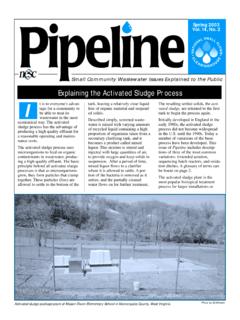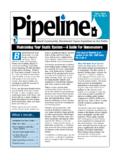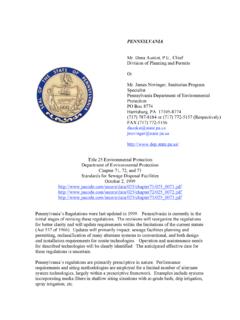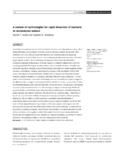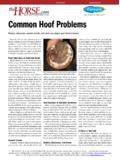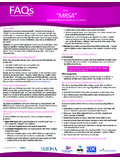Transcription of What are coliform bacteria? Where are these bacteria found?
1 Of Americans get their drinking water from pri-vate wells and National Ground Water Association (NGWA)public surveys show a high level of well owner satisfac-tion. Importantly, the owners of household wells areresponsible for their own well maintenance and water test-ing. And being a good water well steward means havingregular at least yearly tests for coliform bacteria . Hereare the answers to some common questions regarding bac-teria in water from are coliform bacteria ? coliform bacteria originate as organisms in soil or vege-tation and in the intestinal tract of warm-blooded animals(fecal coli). This group of bacteria has long been an indi-cator of water contamination and possible presence ofintestinal parasites and pathogens.
2 coliform bacteria arerelatively simple to identify, are present in much largernumbers than more dangerous pathogens, and react to thenatural environment and treatment processes similarly topathogens. By observing coliform bacteria , the increase ordecrease of many pathogenic bacteria can be estimated. Where are these bacteria found? Sources of bacterial pollution include runoff from wood-lands, pastures, and feedlots; septic tanks and sewageplants; and animals and wild fowl. Domestic animals con-tribute heavily to the bacterial population. Many coliformbacteria may be directly deposited into natural streamsfrom waste in water and runoff from areas with high con-centrations of animals or humans.
3 By Cliff Treyens,Director of Public Awareness,National Ground Water Association20On Tap Winter 2009 How could coliform bacteria enter a watersystem? The most likely sources come from Where the water isused the spigot, sink, or unclean containers. Another isbackflow from a contaminated source such as a sink-topcarbon filter, bucket of water, or puddle at the end of ahose. Also, reduced pressure or suction in long waterlines can draw in bacteria -laden water or soil into pipesthrough , the presence of bacteria is not alwaysrelated to illness. The water could have been contami-nated through improper sampling. Children may becomeill because of unsanitary conditions in the home.
4 Whosampled the water and how? How sanitary are yourpractices in food handling, personal hygiene, Dothe children wash regularly? these are more likelyroutes for contamination than the water itself. Why test for coliform bacteria ? Pathogens the bacteria , protozoa, and viruses thatmake people sick can be rare and difficult to detecteven if they are present in the water. Total coliforms areindicators and are more common and easy to for them provides a margin of safety. Pathogensmay not be present if coliforms are, but it would bewise to look for problems just in coliforms are those that are usually found in thefecal material of animals.
5 Their presence usually meansthat the water may be contaminated by sewage the source of the problem and correcting it isvery important. Should I have my water tested? Routine testing for bacteria , nitrates, and anything elseof concern, even if you do not perceive a change inyour water, is highly recommended. Annual testing canbe valuable because it establishes a record of waterquality. This record can be helpful in solving any futureproblems and in obtaining compensation if someonedamages your water supply. When should I test my water and for whatshould I test? The total coliform (TC) test, which is often used as astandard of a safe water supply, is a place to start.
6 Testannually for coliform bacteria , nitrate, and anything elseof concern. This is best done during the spring or sum-mer following a rainy period. these tests also should beconducted after repairing or replacing an old well,pump, or pipes, and after installing a new well or may also want to test when: Family members or houseguests have recurrentincidents of gastrointestinal illness. An infant is living in the home. You are buying a home and wish to assess thesafety and quality of the existing water supply. You want to monitor the efficiency and perform-ance of home water treatment equipment. You notice a change in the taste, smell, or appear-ance of the water.
7 In a small watershed near Treynor, Iowa, hydrologistMike Burkart (left) and farmer Bill Vorthman drawwater from a 30-foot-deep sampling well to test forherbicides and by Keith Weller, courtesy of TC test will not detect the large majority of bio-fouling organisms or even most bacteria in a well. It isnot uncommon for wells showing no coliforms to havevery large bacterial populations. Some so-called native bacteria will cause a positive coliform reaction in thetotal coliform test, but take any positive as a reason tolook for possible problems. Who should test my water? Your local health department is typically the first will either do a free or inexpensive test for the pres-ence of bacteria , or refer you to a qualified laboratory.
8 Totest for other substances, such as metals or chemicals, amore extensive and costly sampling and testing programwould have to be conducted. The services of an inde-pendent laboratory will probably be required. The Environmental Protection Agency offers astate-by-state listing of certification officers (go ) or call the National GroundWater Association at (800) 551-7379. The certificationofficer in your state can provide a list of certified labs inyour area. How should a water sample be collected? Most testing laboratories or services supply their ownsample containers. Use the containers provided andcarefully follow the instructions given for collecting, pre-serving, and handling water samples.
9 Samples forcoliform bacteria testing must be collected using sterilecontainers and under sterile procedures require that water runs from aninside tap for several minutes before filling the samplecontainers. Others instruct you to collect samples in themorning after water has been confined in the pipesovernight. Sometimes laboratories send a technician tocollect and analyze the sample in your home. Will coliform bacteria make me sick? Most coliforms are harmless residents of soil and willnot make people sick. Some strains of E. coli, the mostcommon fecal coliform bacterium (usually living in ani-mal fecal material), may be pathogens.
10 Some found infood have been lethal. Their presence should be takenvery immune system also determines whether or notyou will become ill. People become accustomed to thenatural bacteria in their water while guests may havesome discomfort or diarrhea. Immunocompromised indi-viduals may become ill under circumstances wherepeople with normal immune systems would not, andsuch individuals should be very careful of the waterthey (disease-producing) organisms occurringin water range from ultra-small viruses to microscopicbacteria to relatively large protozoa (cysts). Bacteriologicand protozoic pathogens are known to cause typhoid,dysentery, cholera, and some types of wisdom is that contamination of ground-water with protozoa indicates surface water account for more than 100 human maladiesincluding polio, infectious hepatitis, and some forms ofgastroenteritis.
